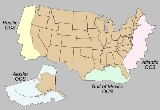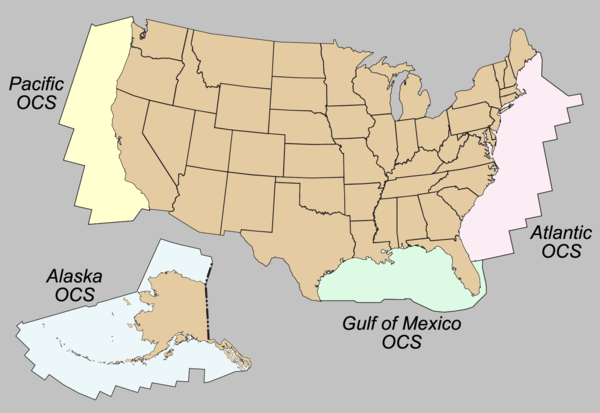
Outer Continental Shelf
Encyclopedia

Political geography
Political geography is the field of human geography that is concerned with the study of both the spatially uneven outcomes of political processes and the ways in which political processes are themselves affected by spatial structures...
of the United States
United States
The United States of America is a federal constitutional republic comprising fifty states and a federal district...
and is the part of the internationally recognized continental shelf of the United States
Continental shelf of the United States
The term continental shelf of the United States has two related meanings. Geologically, it is the total of the continental shelves adjacent to the United States...
which does not fall under the jurisdictions of the individual U.S. state
U.S. state
A U.S. state is any one of the 50 federated states of the United States of America that share sovereignty with the federal government. Because of this shared sovereignty, an American is a citizen both of the federal entity and of his or her state of domicile. Four states use the official title of...
s.
Definition
Formally, the OCS is governed by Title 43Title 43 of the United States Code
Title 43 of the United States Code outlines the role of Public Lands in the United States Code.—Bureau of Land Management—United States Geological Survey—Surveys—District Land Offices—Land Districts—Withdrawal From Settlement, Location, Sale, or Entry—Homesteads—Timber and Stone Lands—Grazing...
, Chapter 29 "Submerged Lands", Subchapter III "Outer Continental Shelf Lands", of the U.S. Code. The term "outer Continental Shelf" refers to all submerged lands, its subsoil, and seabed that belong to the United States and are lying seaward and outside of the states' jurisdiction, the latter defined as the “lands beneath navigable waters" in Title 43, Chapter 29, Subchapter I, Section 1301.
The United States OCS has been divided into four leasing regions:
- Gulf of Mexico OCS Region
- Atlantic OCS Region
- Pacific OCS Region
- Alaska OCS Region
State jurisdiction is defined as follows:
- TexasTexasTexas is the second largest U.S. state by both area and population, and the largest state by area in the contiguous United States.The name, based on the Caddo word "Tejas" meaning "friends" or "allies", was applied by the Spanish to the Caddo themselves and to the region of their settlement in...
and the Gulf coast of Florida are extended 3 marine leaguesLeague (unit)A league is a unit of length . It was long common in Europe and Latin America, but it is no longer an official unit in any nation. The league originally referred to the distance a person or a horse could walk in an hour...
(approximately 9 nautical mileNautical mileThe nautical mile is a unit of length that is about one minute of arc of latitude along any meridian, but is approximately one minute of arc of longitude only at the equator...
s) seaward from the baseline from which the breadth of the territorial sea is measured. - LouisianaLouisianaLouisiana is a state located in the southern region of the United States of America. Its capital is Baton Rouge and largest city is New Orleans. Louisiana is the only state in the U.S. with political subdivisions termed parishes, which are local governments equivalent to counties...
is extended 3 pre1954U.S.nmi seaward of the baseline from which the breadth of the territorial sea is measured (as defined pre-1954 in the U.S.: nautical mile = 6080.2 feet). - All other States' seaward limits are extended 3 international nautical miles (5.556 km/3.452 mi) seaward of the baseline from which the breadth of the territorial sea is measured.
Federal jurisdiction is defined under accepted principles of public international law. The seaward limit is defined as the farthest of 200 nautical miles seaward of the baseline from which the breadth of the territorial sea is measured or, if the continental shelf can be shown to exceed 200 nautical miles, a distance not greater than a line 100 nautical miles from the 2,500-meter isobath or a line 350 nautical miles from the baseline.
Outer Continental Shelf limits greater than 200 nautical miles but less than either the 2,500 meter isobath plus 100 nautical miles or 350 nautical miles are defined by a line 60 nautical miles seaward of the foot of the continental slope or by a line seaward of the foot of the continental slope connecting points where the sediment thickness divided by the distance to the foot of the slope equals 0.01, whichever is farthest.
Coastlines are emergent
Emergent coastline
Emergent coastlines are stretches along the coast that have been exposed by the sea due to a relative fall in sea levels. This occurs due to either isostacy or eustacy....
. Thus the landward boundary of the outer continental shelf is a legal construct rather than a physical construct, modified only at intervals by appropriate processes of law
Law
Law is a system of rules and guidelines which are enforced through social institutions to govern behavior, wherever possible. It shapes politics, economics and society in numerous ways and serves as a social mediator of relations between people. Contract law regulates everything from buying a bus...
.http://www.mms.gov/offshore/mapping/OCSPolicyInfo.htm
For legislation concerning the OCS, the United States Senate Committee on Commerce, Science & Transportation
United States Senate Committee on Commerce, Science and Transportation
The United States Senate Committee on Commerce, Science, and Transportation is a standing committee of the United States Senate in charge of all senate matters related to the following subjects:* Coast Guard* Coastal zone management* Communications...
has jurisdiction within the United States Senate
United States Senate
The United States Senate is the upper house of the bicameral legislature of the United States, and together with the United States House of Representatives comprises the United States Congress. The composition and powers of the Senate are established in Article One of the U.S. Constitution. Each...
. In the House of Representatives, the Committee on Natural Resources Subcommittee on Energy and Mineral Resources has jursidiction over administration and legislation amending the OSCLA.
Within the United States government
Federal government of the United States
The federal government of the United States is the national government of the constitutional republic of fifty states that is the United States of America. The federal government comprises three distinct branches of government: a legislative, an executive and a judiciary. These branches and...
, the Bureau of Ocean Energy Management, Regulation and Enforcement (BOEMRE), also known as the Bureau of Ocean Energy (BOE), and formerly known as the Minerals Management Service (MMS), is the agency charged to provide regulatory oversight of deepwater oil drilling and offshore wind energy sources in U.S. Federal waters that extend beyond State jurisdiction.
See also
- Coastal geographyCoastal geographyCoastal geography is the study of the dynamic interface between the ocean and the land, incorporating both the physical geography and the human geography of the coast...
- Beach evolutionBeach evolutionThe shoreline is where the land meets the sea and it is continually changing. Over the long term, the water is eroding the land. Beaches represent a special case, in that they exist where sand accumulated from the same processes that strip away rocky and sedmientary material. I.e., they can grow as...
- Chukchi Sea ShelfChukchi Sea ShelfThe Chukchi Sea Shelf or Chukchi Shelf is the easternmost part of the Continental shelf of Russia and the westernmost part of the Continental shelf of the United States...
- International Boundary and Water CommissionInternational Boundary and Water CommissionThe International Boundary and Water Commission is an international body created in 1889 by the United States and Mexico to administer the many boundary and water-rights treaties and agreements between the two nations....
- Law of the Sea TreatyUnited Nations Convention on the Law of the SeaThe United Nations Convention on the Law of the Sea , also called the Law of the Sea Convention or the Law of the Sea treaty, is the international agreement that resulted from the third United Nations Conference on the Law of the Sea , which took place from 1973 through 1982...
- Maritime Security (USCG)Maritime Security (USCG)Maritime security is concerned with the prevention of intentional damage through sabotage, subversion, or terrorism. Maritime security is one of the three basic roles of the United States Coast Guard has gradually developed in response to a series of catastrophic events, which began in 1917.There...
- Maritime Security RegimesMaritime Security RegimesMaritime Security Regimes are codes and conventions of behavior agreed upon by coastal states to provide a degree of security within territorial waters and on the high seas.-Purpose:...
- UNEP Shelf Programme
- Coastal States OrganizationCoastal States OrganizationThe Coastal States Organization is a U.S. non-profit organization located in Washington D.C. that represents the Governors of the nation’s thirty-five coastal states, commonwealths and territories. CSO represents the Governors on legislative and policy issues relating to the sound management of...

